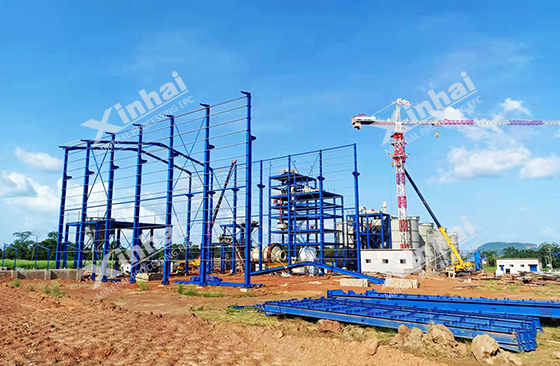
In the gold ore dressing process, cyanidation process is widely used due to its high gold extraction rate. With the increasingly stringent environmental protection requirements and the continuous improvement of resource utilization efficiency, the optimization of gold concentrate cyanidation process has become the focus of current mining development. This article will systematically explore the optimization methods of gold ore cyanidation process around different process links such as ore flotation, roasting, biological oxidation, hot pressure oxidation and cyanide residue filter washing.
.jpg)
The roasting method is to decompose the sulfide minerals encapsulating gold into porous oxides under high temperature and aeration conditions, exposing the gold impregnated therein. This process has a wide range of adaptability to ores, is easy to operate, simple to maintain, and has reliable technology. However, the roasting process will release toxic gases such as SO2 and As2O3, which pollute the environment.

Optimization measures
1. Improvement of environmental protection technology: adopt advanced waste gas treatment technology to reduce the emission of toxic gases such as SO2 and As2O3 to protect the environment.
2. Comprehensive utilization of by-products: explore ways to comprehensively utilize by-products other than sulfuric acid to improve economic benefits.
3. Process monitoring and optimization: optimize roasting temperature and gas flow through intelligent monitoring system to ensure efficient and stable roasting process.
The biooxidation process uses microorganisms in nature to directly or indirectly oxidize and decompose sulfide minerals, destroy harmful components such as pyrite and arsenopyrite that wrap gold, and fully expose the gold, thereby creating favorable conditions for the subsequent cyanidation gold ore extraction process. The direct effect of biooxidation is that microorganisms attach to the surface of the ore and react with the sulfide minerals in the ore to oxidize and dissolve the minerals; the indirect effect is that the ore is chemically dissolved under the action of ferrous sulfate and sulfuric acid produced during the metabolism of microorganisms.

Optimization measures
1. Microbial screening and cultivation: Screen and cultivate microbial strains with strong adaptability and high oxidation efficiency to improve the biooxidation effect.
2. Process condition optimization: Optimize process parameters such as temperature, pH value, and oxygen supply to ensure the best growth and metabolic environment for microorganisms.
3. Wastewater treatment and recycling: Strengthen the treatment and recycling of wastewater in the process of biooxidation to reduce environmental pollution.
The hot pressure oxidation process uses air or high-purity oxygen to perform hot pressure oxidation in an autoclave to expose all the encapsulated gold, and then cyanide leaching can obtain high-quality concentrate. The process has strong adaptability and can be carried out in both acidic and alkaline media, and can treat both raw ore and concentrate. However, the hot pressure oxidation process requires strict control of the concentrations of Cl-, Na+, and SO42- in the slurry, otherwise it will have a significant side effect on the pretreatment effect of the ore and the equipment.

Optimization measures
1. Process parameter control: Strictly control the concentrations of Cl-, Na+, and SO42- in the slurry to ensure the stability and effectiveness of the hot pressure oxidation process.
2. Equipment anti-corrosion measures: Use corrosion-resistant materials to manufacture equipment, and add anti-corrosion protective layers to key parts to extend the service life of the equipment.
3. Waste liquid treatment and recovery: Strengthen the treatment and recovery of waste liquid generated during hot pressure oxidation to reduce the impact on the environment.
With the development of filter press dry stacking technology, the main treatment process of gold ore cyanide tailings slurry is to separate the slag and liquid after filter press, dry stack the filter residue, and recycle or discharge the filtrate after treatment. At present, most gold production enterprises use plate and frame filter presses or ceramic filters with only simple filter press function for tailings filter press, and the minimum moisture content of the filtered tailings is 20%. This causes a large amount of cyanide and valuable metals to be brought into the tailings pond through tailings adsorption and moisture in the tailings, causing losses.

Optimization measures
1. Application of high-efficiency filter press: Use high-efficiency filter presses with filter press, washing and air drying functions to reduce the moisture content of the filter residue.
2. Recovery of valuable metals: Through the washing treatment of high-efficiency filter presses, cyanide and valuable metals such as gold, silver, and copper adsorbed on the surface of cyanide slag are recovered.
3. Recycling of filtrate: The filtrate generated during the filter press is recycled after treatment to reduce the use of fresh water and reduce production costs.

Optimization of the gold ore cyanidation process is the key to improving gold ore dressing efficiency and environmental friendliness. In different process links such as raw ore flotation-roasting, raw ore flotation-biooxidation, raw ore flotation-hot pressure oxidation and cyanide residue filter pressing and washing, the use of advanced technologies and optimization measures can not only improve the gold recovery rate, but also effectively reduce environmental pollution. In the future, with the continuous advancement of science and technology and increasingly stringent environmental protection requirements, the gold concentrate cyanidation process will continue to develop in the direction of high efficiency, environmental protection and economy, providing a strong guarantee for the sustainable development of the gold mining industry.
To find out more about our products and solutions, please fill out the form below and one of our experts will get back to you shortly.